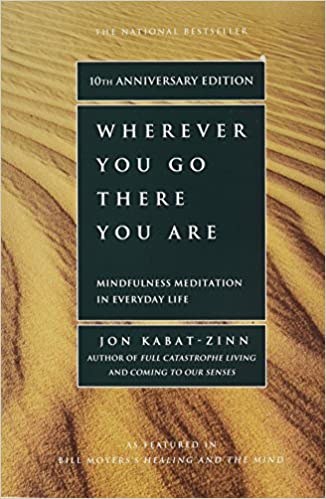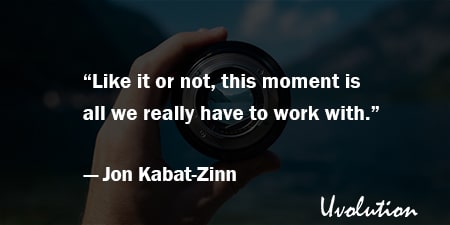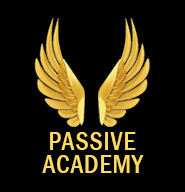Wherever You Go There You Are by Jon Kabat-Zinn
The Book in 1 Sentences
Wherever You Go, There You Are: Mindfulness Meditation in Everyday Life
“When we speak of meditation, it is important for you to know that this is not some weird cryptic activity, as our popular culture might have it. It does not involve becoming some kind of zombie, vegetable, self-absorbed narcissist, navel gazer, “space cadet,” cultist, devotee, mystic, or Eastern philosopher.
Meditation is simply about being yourself and knowing something about who that is. It is about coming to realize that you are on a path whether you like it or not, namely, the path that is your life. Meditation may help us see that this path we call our life has direction; that it is always unfolding, moment by moment; and that what happens now, in this moment, influences what happens next.” ~ Jon Kabat-Zinn
10 BIG Ideas
Wherever You Go There You Are Book Summary
1. Meditation Practice
“Meditation means learning how to get out of this current, sit by its bank and listen to it, learn
from it, and then use its energies to guide us rather than to tyrannize us.
This process doesn’t magically happen by itself. It takes energy. We call the effort to cultivate our ability to be in the present moment “practice” or “meditation practice.””
“Meditation is the process by which we go about deepening our attention and awareness, refining them, and putting them to greater practical use in our lives.”
2. Concentration = Samadhi = “Onepointedness”
“Concentration is a cornerstone of mindfulness practice. Your mindfulness will only be as robust as the capacity of your mind to be calm and stable.”
“You can think of concentration as the capacity of the mind to sustain an unwavering attention on one object of observation. It is cultivated by attending to one thing, such as the breath, and just limiting one’s focus to that.
In Sanskrit, concentration is called samadhi, or “onepointedness.”
Samadhi is developed and deepened by continually bringing the attention back to the breath every time it wanders.
When practicing strictly concentrative forms of meditation, we purposefully refrain from any efforts to inquire into areas such as where the mind went when it wandered off, or that the quality of the breath fluctuates.
Our energy is directed solely toward experiencing this breath coming in, this breath going out, or some other single object of attention. With extended practice, the mind tends to become better and better at staying on the breath, or noticing even the earliest impulse to become distracted by something else, and either resisting its pull in the first place and staying on the breath, or quickly returning to it.”
“The stability and calmness which come with onepointed concentration practice form the foundation for the cultivation of mindfulness. Without some degree of samadhi, your mindfulness will not be very strong.
You can only look deeply into something if you can sustain your looking without being constantly thrown off by distractions or by the agitation of your own mind. The deeper your concentration, the deeper the potential for mindfulness.”
3. Define Your "WHY"
“If you hope to bring meditation into your life in any kind of long-term, committed way, you will need a vision that is truly your own—one that is deep and tenacious and that lies close to the core of who you believe yourself to be, what you value in your life, and where you see yourself going.
Only the strength of such a dynamic vision and the motivation from which it springs can possibly keep you on this path year in and year out, with a willingness to practice every day and to bring mindfulness to bear on whatever is happening, to open to whatever is perceived, and to let it point to where the holding is and where the letting go and the growing need to happen.”
“It is virtually impossible, and senseless anyway, to commit yourself to a daily meditation practice without some view of why you are doing it, what its value might be in your life, a sense of why this might be your way and not just another tilting at imaginary windmills.”
“TRY: Asking yourself why you meditate or why you want to meditate. Don’t believe your first answers. Just write down a list of whatever comes to mind. Continue asking yourself.
Also, inquire about your values, about what you honor most in your life. Make a list of what is really important to you. Ask yourself: What is my vision, my map for where I am and where I am going? Does this vision reflect my true values and intentions? Am I remembering to embody those values? Do I practice my intentions? How am I now in my job, in my family, in my relationships, with myself? How do I want to be? How might I live my vision, my values? How do I relate to suffering, both my own and others?”
“I don’t know of any magical solutions and, frankly, I am not looking for one. A full life is painted with broad brush strokes. Many paths can lead to understanding and wisdom. Each of us has different needs to address and things worth pursuing over the course of a lifetime. Each of us has to chart our own course, and it has to fit what we are ready for.”
4. Practice.. Every Moment!
“If mindfulness is deeply important to you, then every moment is an opportunity to practice.”
Genpo Roshi’s - in the great book Big Mind Big Heart - also tells us: “We’re at the point in our evolution that we all have to become conscious. This is a time of revolution. There’s no holding back. So I’m about tearing down the monastery walls and seeing the whole world as the monastery, as the practice, as the spiritual temple. What we’re all working on is this very being, this very life. This is the temple, it has no walls.”
5. Development Through Mental Training
“I am told that in Pali, the original language of the Buddha, there is no one word corresponding to our word “meditation,” even though meditation might be said to have evolved to an extraordinary degree in ancient Indian culture. One word that is frequently used is bhavana.
Bhavana translates as “development through mental training.” To me, this strikes the mark; meditation really is about human development.”
6. Observing Your Thoughts
“Meditation does not involve trying to change your thinking by thinking some more. It involves watching thought itself.”
“Another way to look at meditation is to view the process of thinking itself as a waterfall, a continual cascading of thought. In cultivating mindfulness, we are going beyond or behind our thinking, much the way you might find a vantagepoint in a cave or depression in the rock behind a waterfall. We still see and hear the water, but we are out of the torrent.”
7. Sit With Dignity
“When we describe the sitting posture, the word that feels the most appropriate is “dignity.”
Sitting down to meditate, our posture talks to us. It makes its own statement. You might say the posture itself is the meditation.
If we slump, it reflects low energy, passivity, a lack of clarity. If we sit ramrod-straight, we are tense, making too much of an effort, trying too hard. When I use the word “dignity” in teaching situations, as in “Sit in a way that embodies dignity,” everybody immediately adjusts their posture to sit up straighter.
But they don’t stiffen. Faces relax, shoulders drop, head, neck, and back come into easy alignment. The spine rises out of the pelvis with energy.
Sometimes people tend to sit forward, away from the backs of their chairs, more autonomously. Everybody seems to instantly know that inner feeling of dignity and how to embody it.”
8. Daily Discipline
“One of the principle virtues of a daily discipline is an acquired transparency toward the appeals of transitory mood states. A commitment to getting up early to meditate becomes independent of wanting or not wanting to do so on any particular morning.
The practice calls us to a higher standard—that of remembering the importance of wakefulness and the ease with which we can slip into a pattern of automatic living which lacks awareness and sensitivity.
Just waking up early to practice non-doing is itself a tempering process. It generates enough heat to rearrange atoms, gives us a new and stronger crystal lattice of mind and body, a lattice that keeps us honest and reminds us that there is far more to life than getting things done.
Discipline provides a constancy which is independent of what kind of day you had yesterday and what kind of day you anticipate today.”
David Reynolds - in his great book Constructive Living- also says: “The mature human being goes about doing what needs to be done regardless of whether that person feels great or terrible.
Knowing that you are the kind of person with that kind of self-control brings all the satisfaction and confidence you will ever need. Even on days when the satisfaction and confidence just aren’t there, you can get the job done anyway.”
9. Just Feeling The Breath!
“It helps to have a focus for your attention, an anchor line to tether you to the present moment and to guide you back when the mind wanders. The breath serves this purpose exceedingly well.
It can be a true ally. Bringing awareness to our breathing, we remind ourselves that we are here now, so we might as well be fully awake for whatever is already happening.”
“To use your breathing to nurture mindfulness, just tune in to the feeling of it… the feeling of the breath coming into your body and the feeling of the breath leaving your body. That’s all.
Just feeling the breath. Breathing and knowing that you’re breathing. This doesn’t mean deep breathing or forcing your breathing, or trying to feel something special, or wondering whether you’re doing it right. It doesn’t mean thinking about your breathing, either. It’s just a bare bones awareness of the breath moving in and the breath moving out.”
10. What is my job on the planet?
“asking, “What is it on this planet [which he referred to as Spaceship Earth] that needs doing that I know something about, that probably won’t happen unless I take responsibility for it?
He decided he would just ask that question continuously and do what came to him, following his nose. In this way, working for humanity as an employee of the universe at large, you get to modify and contribute to your locale by who you are, how you are, and what you do.
But it’s no longer personal. It’s just part of the totality of the universe expressing itself.
Rarely do we question and then contemplate with determination what our hearts are calling us to do and to be.
I like to frame such efforts in question form: “What is my job on the planet with a capital J?” or, “What do I care about so much that I would pay to do it?” If I ask such a question and I don’t come up with an answer other than, “I don’t know,” then I just keep on asking the question.”
““What is my job on the planet?” is one question we might do well to ask ourselves over and over again. Otherwise, we may wind up doing somebody else’s job and not even know it. ”
“Once the universe is your employer, very interesting things start to happen, even if someone else is cutting your paycheck. But you do have to be patient. It takes time to grow this way of being into your life. The place to start of course is right here. The best time? How about now?”
That was my QUICK summary of the great book Wherever You Go There You Are by Jon Kabat-Zinn. If you’re interested, get your copy. There is a HUGE amount of life-changing ideas in this book, and we’ve only touched on a tiny bit of it.
Buy The Book: Wherever You Go There You Are by Jon Kabat-Zinn

GET Blinkist 7 Days FREE Trial
3000+ Book Summaries
(Audio and Text)








